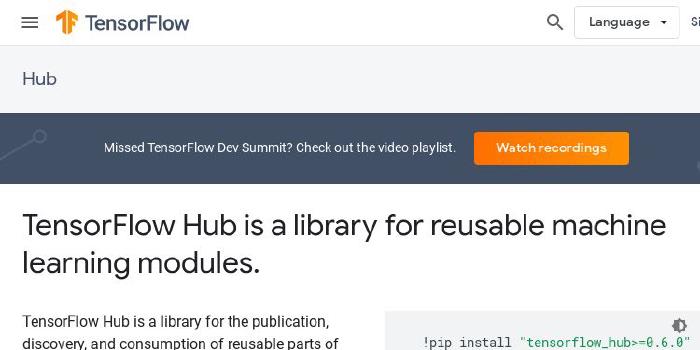dathudeptrai/TensorflowTTS

:stuck_out_tongue_closed_eyes: TensorflowTTS: Real-Time State-of-the-art Speech Synthesis for Tensorflow 2
| repo name | dathudeptrai/TensorflowTTS |
| repo link | https://github.com/dathudeptrai/TensorflowTTS |
| homepage | https://dathudeptrai.github.io/TensorflowTTS/ |
| language | Python |
| size (curr.) | 28236 kB |
| stars (curr.) | 248 |
| created | 2020-03-22 |
| license | Apache License 2.0 |
:zany_face: TensorflowTTS provides real-time state-of-the-art speech synthesis architectures such as Tacotron-2, Melgan, Multiband-Melgan, FastSpeech, FastSpeech2 based-on TensorFlow 2. With Tensorflow 2, we can speed-up training/inference progress, optimizer further by using fake-quantize aware and pruning, make TTS models can be run faster than real-time and be able to deploy on mobile devices or embedded systems.
What’s new
- 2020/06/20 (New!) FastSpeech2 implementation with Tensorflow is supported.
- 2020/06/07 (New!) Multi-band MelGAN (MB MelGAN) implementation with Tensorflow is supported.
Features
- High performance on Speech Synthesis.
- Be able to fine-tune on other languages.
- Fast, Scalable and Reliable.
- Suitable for deployment.
- Easy to implement new model based-on abtract class.
- Mixed precision to speed-up training if posible.
Requirements
This repository is tested on Ubuntu 18.04 with:
- Python 3.6+
- Cuda 10.1
- CuDNN 7.6.5
- Tensorflow 2.2
- Tensorflow Addons 0.9.1
Different Tensorflow version should be working but not tested yet. This repo will try to work with latest stable tensorflow version.
Installation
$ git clone https://github.com/dathudeptrai/TensorflowTTS.git
$ cd TensorflowTTS
$ pip install .
If you want upgrade the repository and its dependencies:
$ git pull
$ pip install --upgrade .
Supported Model achitectures
TensorflowTTS currently provides the following architectures:
- MelGAN released with the paper MelGAN: Generative Adversarial Networks for Conditional Waveform Synthesis by Kundan Kumar, Rithesh Kumar, Thibault de Boissiere, Lucas Gestin, Wei Zhen Teoh, Jose Sotelo, Alexandre de Brebisson, Yoshua Bengio, Aaron Courville.
- Tacotron-2 released with the paper Natural TTS Synthesis by Conditioning WaveNet on Mel Spectrogram Predictions by Jonathan Shen, Ruoming Pang, Ron J. Weiss, Mike Schuster, Navdeep Jaitly, Zongheng Yang, Zhifeng Chen, Yu Zhang, Yuxuan Wang, RJ Skerry-Ryan, Rif A. Saurous, Yannis Agiomyrgiannakis, Yonghui Wu.
- FastSpeech released with the paper FastSpeech: Fast, Robust and Controllable Text to Speech by Yi Ren, Yangjun Ruan, Xu Tan, Tao Qin, Sheng Zhao, Zhou Zhao, Tie-Yan Liu.
- Multi-band MelGAN released with the paper Multi-band MelGAN: Faster Waveform Generation for High-Quality Text-to-Speech by Geng Yang, Shan Yang, Kai Liu, Peng Fang, Wei Chen, Lei Xie.
- FastSpeech2 released with the paper FastSpeech 2: Fast and High-Quality End-to-End Text to Speech by Yi Ren, Chenxu Hu, Xu Tan, Tao Qin, Sheng Zhao, Zhou Zhao, Tie-Yan Liu.
We are also implement some techniques to improve quality and convergence speed from following papers:
- Multi Resolution STFT Loss released with the paper Parallel WaveGAN: A fast waveform generation model based on generative adversarial networks with multi-resolution spectrogram by Ryuichi Yamamoto, Eunwoo Song, Jae-Min Kim.
- Guided Attention Loss released with the paper Efficiently Trainable Text-to-Speech System Based on Deep Convolutional Networks with Guided Attention by Hideyuki Tachibana, Katsuya Uenoyama, Shunsuke Aihara.
Audio Samples
Here in an audio samples on valid set. tacotron-2, fastspeech, melgan, melgan.stft, fastspeech2
Tutorial End-to-End
Prepare Dataset
Prepare a dataset in the following format:
|- datasets/
| |- metadata.csv
| |- wav/
| |- file1.wav
| |- ...
where metadata.csv has the following format: id|transcription. This is a ljspeech-like format, you can ignore preprocessing step if you have other format dataset.
Preprocessing
The preprocessing have three steps:
- Convert charactor to ids, calculate pre-normalize melspectrogram, normalize audio to [-1, 1], split dataset into train and valid part.
- Computer mean/var of melspectrogram over training part.
- Normalize melspectrogram based-on mean/var of training dataset.
This is a command line to do three steps above:
tensorflow-tts-preprocess --rootdir ./datasets/ --outdir ./dump/ --conf preprocess/ljspeech_preprocess.yaml
tensorflow-tts-compute-statistics --rootdir ./dump/train/ --outdir ./dump --config preprocess/ljspeech_preprocess.yaml
tensorflow-tts-normalize --rootdir ./dump --outdir ./dump --stats ./dump/stats.npy --config preprocess/ljspeech_preprocess.yaml
After preprocessing, a structure of project will become:
|- datasets/
| |- metadata.csv
| |- wav/
| |- file1.wav
| |- ...
|- dump/
| |- train/
| |- ids/
| |- LJ001-0001-ids.npy
| |- ...
| |- raw-feats/
| |- LJ001-0001-raw-feats.npy
| |- ...
| |- raw-f0/
| |- LJ001-0001-raw-f0.npy
| |- ...
| |- raw-energies/
| |- LJ001-0001-raw-energy.npy
| |- ...
| |- norm-feats/
| |- LJ001-0001-norm-feats.npy
| |- ...
| |- wavs/
| |- LJ001-0001-wave.npy
| |- ...
| |- valid/
| |- ids/
| |- LJ001-0009-ids.npy
| |- ...
| |- raw-feats/
| |- LJ001-0009-raw-feats.npy
| |- ...
| |- raw-f0/
| |- LJ001-0001-raw-f0.npy
| |- ...
| |- raw-energies/
| |- LJ001-0001-raw-energy.npy
| |- ...
| |- norm-feats/
| |- LJ001-0009-norm-feats.npy
| |- ...
| |- wavs/
| |- LJ001-0009-wave.npy
| |- ...
| |- stats.npy/
| |- stats_f0.npy/
| |- stats_energy.npy/
| |- train_utt_ids.npy
| |- valid_utt_ids.npy
|- examples/
| |- melgan/
| |- fastspeech/
| |- tacotron2/
| ...
Where stats.npy contains mean/var of train melspectrogram (we can use mean/var to de-normalization to get melspectrogram raw), stats_energy.npy is a min/max value of energy values over Training dataset, stats_f0 is a min/max value of F0 values, train_utt_ids/valid_utt_ids contains training and valid utt ids respectively. We use suffix (ids, raw-feats, norm-feats, wave) for each type of input.
IMPORTANT NOTES:
- This preprocessing step based-on ESP-NET so you can combine all models here with other models from espnet repo.
Training models
To know how to training model from scratch or fine-tune with other datasets/languages, pls see detail at example directory.
- For Tacotron-2 tutorial, pls see example/tacotron2
- For FastSpeech tutorial, pls see example/fastspeech
- For FastSpeech2 tutorial, pls see example/fastspeech2
- For MelGAN tutorial, pls see example/melgan
- For MelGAN + STFT Loss tutorial, pls see example/melgan.stft
- For Multiband-MelGAN tutorial, pls see example/multiband_melgan
Abstract Class Explaination
Abstract DataLoader Tensorflow-based dataset
A detail implementation of abstract dataset class from tensorflow_tts/dataset/abstract_dataset. There are some functions you need overide and understand:
- get_args: This function return argumentation for generator class, normally is utt_ids.
- generator: This funtion have an inputs from get_args function and return a inputs for models.
- get_output_dtypes: This function need return dtypes for each element from generator function.
- get_len_dataset: Return len of datasets, normaly is len(utt_ids).
IMPORTANT NOTES:
- A pipeline of creating dataset should be: cache -> shuffle -> map_fn -> get_batch -> prefetch.
- If you do shuffle before cache, the dataset won’t shuffle when it re-iterate over datasets.
- You should apply map_fn to make each elements return from generator function have a same length before get batch and feed it into a model.
Some examples to use this abstract_dataset are tacotron_dataset.py, fastspeech_dataset.py, melgan_dataset.py.
Abstract Trainer Class
A detail implementation of base_trainer from tensorflow_tts/trainer/base_trainer.py. It include Seq2SeqBasedTrainer and GanBasedTrainer inherit from BasedTrainer. There a some functions you MUST overide when implement new_trainer:
- compile: This function aim to define a models, and losses.
- _train_step: This function perform one step training logic of a model.
- _eval_epoch: This function perform eval epoch, include _eval_step, generate_and_save_intermediate_result and _write_to_tensorboard.
- _eval_step: This function perform evaluation steps, calculate loss and write it into tensorboard.
- _check_log_interval: This function write training loss into tensorboard after pre-define interval steps.
- generate_and_save_intermediate_result: This function will save intermediate result such as: plot alignment, save audio generated, plot mel-spectrogram …
- _check_train_finish: Check if a training progress finished or not.
All models on this repo are trained based-on GanBasedTrainer (see train_melgan.py, train_melgan_stft.py, train_multiband_melgan.py) and Seq2SeqBasedTrainer (see train_tacotron2.py, train_fastspeech.py). In the near future, we will implement MultiGPU for BasedTrainer class.
End-to-End Examples
You can know how to inference each model at notebooks or see a colab. Here is an example code for end2end inference with fastspeech and melgan.
import numpy as np
import soundfile as sf
import yaml
import tensorflow as tf
from tensorflow_tts.processor import LJSpeechProcessor
from tensorflow_tts.configs import FastSpeechConfig
from tensorflow_tts.configs import MelGANGeneratorConfig
from tensorflow_tts.models import TFFastSpeech
from tensorflow_tts.models import TFMelGANGenerator
# initialize fastspeech model.
with open('./examples/fastspeech/conf/fastspeech.v1.yaml') as f:
fs_config = yaml.load(f, Loader=yaml.Loader)
fs_config = FastSpeechConfig(**fs_config["fastspeech_params"])
fastspeech = TFFastSpeech(config=fs_config, name="fastspeech")
fastspeech._build()
fastspeech.load_weights("./examples/fastspeech/pretrained/model-195000.h5")
# initialize melgan model
with open('./examples/melgan/conf/melgan.v1.yaml') as f:
melgan_config = yaml.load(f, Loader=yaml.Loader)
melgan_config = MelGANGeneratorConfig(**melgan_config["generator_params"])
melgan = TFMelGANGenerator(config=melgan_config, name='melgan_generator')
melgan._build()
melgan.load_weights("./examples/melgan/pretrained/generator-1500000.h5")
# inference
processor = LJSpeechProcessor(None, cleaner_names="english_cleaners")
ids = processor.text_to_sequence("Recent research at Harvard has shown meditating for as little as 8 weeks, can actually increase the grey matter in the parts of the brain responsible for emotional regulation, and learning.")
ids = tf.expand_dims(ids, 0)
# fastspeech inference
masked_mel_before, masked_mel_after, duration_outputs = fastspeech.inference(
ids,
attention_mask=tf.math.not_equal(ids, 0),
speaker_ids=tf.zeros(shape=[tf.shape(ids)[0]]),
speed_ratios=tf.constant([1.0], dtype=tf.float32)
)
# melgan inference
audio_before = melgan(masked_mel_before)[0, :, 0]
audio_after = melgan(masked_mel_after)[0, :, 0]
# save to file
sf.write('./audio_before.wav', audio_before, 22050, "PCM_16")
sf.write('./audio_after.wav', audio_after, 22050, "PCM_16")
Contact
dathudeptrai: nguyenquananhminh@gmail.com, erogol: erengolge@gmail.com
License
This work is licensed under the Apache 2.0
Acknowledgement
We would like to thank Tomoki Hayashi, who discussed with our much about Melgan, Multi-band melgan, Fastspeech and Tacotron. This framework based-on his great open-source ParallelWaveGan project.






